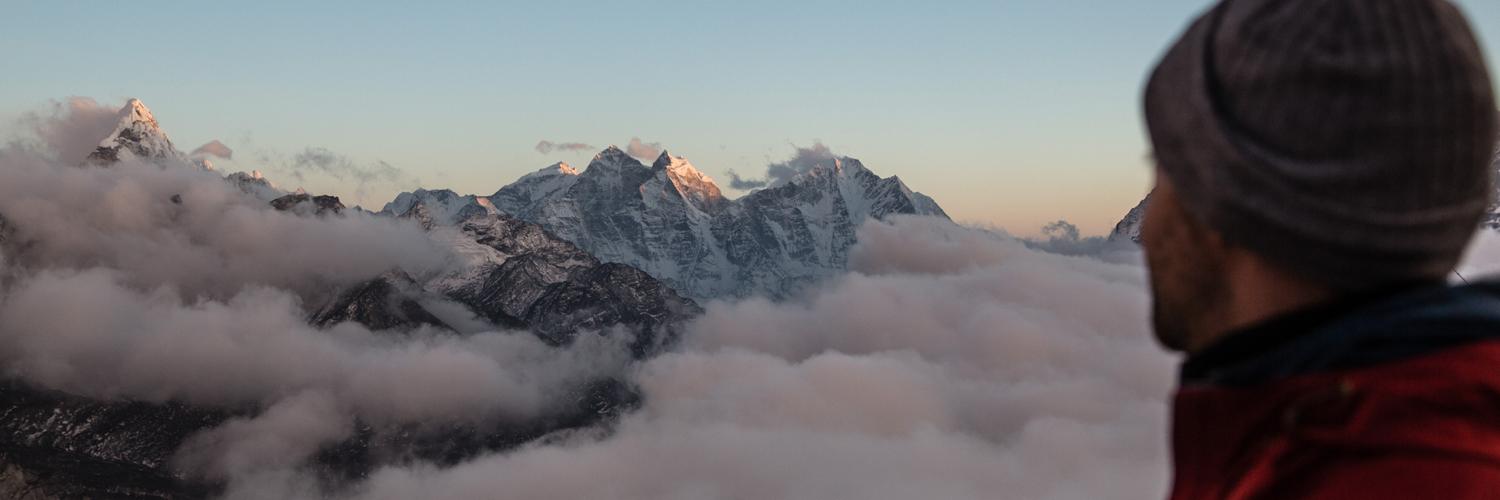The Everest region, renowned for its majestic allure and breathtaking beauty, boasts numerous spectacular viewpoints beyond comparison. Let's explore some of the finest viewpoints that offer a captivating tour through this remarkable region.
The purposeful viewpoints in the Everest Region unveil the myriad offerings of this breathtaking locale. Concealing valleys and awe-inspiring mountains, the mystical landscapes here play a game of hide-and-seek, surprising all who behold their beauty.
Nepal's distinction as the host to eight of the world's fourteen highest peaks elevates the significance of these viewpoints beyond mere statistics; they become the gateways to fulfilling dreams.
Whether viewed up close or from a distance, whether from the west or the east, from high vantage points or down in the valleys, the Everest Region abounds with landmarks waiting to be discovered during trekking in Nepal. Below are listed some of the best viewpoints in the Everest region:
Namche Bazaar (3,440 meters)
Located at an elevation of 3,440 meters (11,290 feet), this must-visit viewpoint lies within the renowned Solukhumbu district. Nestled amidst towering mountains, it is often referred to as the unofficial capital of the Khumbu region and serves as a bustling hub for trekkers en route to the Everest Base Camp.
Among the array of viewpoints in the Everest region, the Namche Bazaar viewpoint stands out for its mesmerizing blend of natural beauty, rich cultural heritage, and the dedicated locals who actively preserve this unique tapestry of traditions.
Additionally, it serves as a renowned acclimatization spot for trekkers, especially those journeying towards the Everest Base Camp or other high-altitude destinations. Even if someone isn't trekking all the way to Everest Base Camp, Namche can still be included in the itinerary, especially during shorter treks like the Everest Panorama Trek.
From this vantage point, visitors are treated to incredible panoramic vistas of the surrounding Himalayan peaks, showcasing the world's tallest, Mount Everest. Alongside Everest, prominent mountains like Lhotse (8,516m), Nuptse (7,861m), Ama Dablam (6,812m), Kangtega (6,782m), and Thamserku (6,608m) contribute to the awe-inspiring backdrop that embellishes the beauty of Namche Bazaar.
The viewpoint also offers captivating sunrise and sunset vistas. At sunrise, the mountains undergo a stunning transformation from dark silhouettes to brilliantly illuminated giants, while during sunset, the setting sun casts soft hues of pink and orange across both the mountains and the sky, creating a mesmerizing spectacle.
Hotel Everest View (3,880 meters)
In the midst of various hotels, guesthouses, and lodges that provide essential services and boast remarkable vistas in the Everest Region, the Everest View Hotel holds notable distinction. Established in 1971, it stands out for offering a unique blend of hospitality along with the privilege of breathtaking panoramic views.
Situated within the confines of the Sagarmatha National Park, a UNESCO World Heritage Site, this hotel sits at an impressive altitude of 3,880 meters (12,729 feet). Recognized by the Guinness Book of World Records in 2004 as the Highest Placed Hotel globally, this resort stands as a distinguished destination in its own right.
Diverging from other viewpoints in the Everest region, the Hotel Everest View offers a distinct and unparalleled experience to its guests. It perfectly captures the essence of a celestial escape, combining luxury with breathtaking beauty. This unique viewpoint stands out as an extraordinary and singular destination.
The vistas witnessed from Hotel Everest View during both sunrise and sunset are truly extraordinary. As the golden hues of sunlight caress the mountain peaks, creating an ethereal halo-like effect, the views transcend beyond ordinary beauty. They evoke a sense of sacred magnificence, delivering an unparalleled and transcendental experience for all who behold them.
Due to its strategic positioning, the hotel offers unparalleled views of the majestic mountains surrounding the Everest Region. Guests can marvel at prominent peaks such as Mount Everest (8,849m), Lhotse (8,516m), Nuptse (7,861m), Ama Dablam (6,812m), Thamserku (6,608m), Kangtega (6,782m), and Taboche (6,495m) among others, creating a panoramic spectacle that captivates the senses from Hotel Everest View.
Tengboche (3,860 meters)
Tengboche is yet another noteworthy viewpoint in the Everest region, situated in Khumbu at an elevation of 3,860 meters (12,687 feet). This village serves as a favored stopover for trekkers en route to the Everest Base Camp, doubling as a crucial acclimatization spot owing to its higher elevation.
Nestled within a picturesque landscape, the village of Tengboche presents a charming scene that transitions from terraced fields, encompassing quaint Sherpa houses, to the vibrant backdrop of rhododendron forests, all contributing to its captivating panorama.
The vistas from Tengboche are not just delightful; they are, in fact, awe-inspiring. The Himalayas unveil themselves in breathtaking frames, showcasing some of the world's highest peaks such as Ama Dablam (6,812m) and Mount Everest (8,849m) in close proximity, presenting a spectacle that captivates the eyes and soul from the vantage point of Tengboche.
Among its many notable features, the Tengboche Monastery stands out as the largest and most significant monastery in the region. Its stunning architecture not only embodies profound religious and cultural importance but also contributes significantly to the overall beauty and charm of the area.
The sunrise and sunset scenes witnessed from Tengboche are undeniably spectacular. With the sun ascending and descending against the Himalayas, the interplay of light and reflection paints an almost surreal canvas of vibrant colors streaking across the sky. Harmonizing flawlessly with its surroundings, this captivating display of colors elevates the enchantment of Tengboche, adding an extra layer of magic to its already mesmerizing allure.
The sunrise and sunset panoramas from Tengboche are breathtakingly stunning. With the sun ascending and descending against the Himalayas, the shifting interplay of light and reflections creates an almost surreal explosion of colorful streaks in the sky. Complementing its natural surroundings perfectly, this display of hues further enhances the enchantment of Tengboche, adding an extra layer of magic to its inherent allure.
Nangkartshang Peak (5,083 meters)
The Nangkartshang Peak, standing proudly at an altitude of 5083 meters (16,677 feet), is situated directly above the village of Dingboche within the Khumbu region.
This viewpoint serves as another vital acclimatization spot in the Everest region, aiding trekkers in adapting to the rigors of their journey towards the Everest Base Camp while taking respite in Dingboche.
The Nangkartshang Peak presents breathtaking vistas encompassing several prominent mountain ranges, including Ama Dablam (6,812m), Makalu (8,481m), Lhotse (8,516m), Kantega (6,782m), and Cho Oyu (8,188m).
Its accessibility and relatively manageable ascent enable trekkers to relish the majority of their journey up to its summit. Due to its reach and vantage point, Nangkartshang is renowned for offering one of the most stunning panoramas compared to other viewpoints with similar topography in the area.
Chhukung Ri (5,546 meters)
Chhukung Ri, a renowned rocky peak in the Everest region nestled within the Solukhumbu district, stands proudly at an altitude of 5,546 meters (18,196 feet). Known for its moderate difficulty level and accessibility, it serves as a prime spot for trekkers to acclimatize before ascending to higher altitudes.
This location offers breathtaking vistas of world-famous mountain ranges, guiding trekkers through enchanting forests adorned with a variety of wildflowers and flora such as rhododendrons, oaks, and pines.
Although Chhukung Ri provides captivating views of AmaDablam (6,812m), Imja Tse, better known as Island Peak (6,165m), Nuptse (7,861m), and Makalu (8,481m), it's important to note that Mount Everest itself isn't among the visible peaks from Chhukung Ri's vantage point.
Kala Patthar (5,550 meters): The Ultimate Panoramic Spot in the Everest Region
Kala Patthar is considered one of the Everest Region's most popular viewpoints at an elevation of 5,550 meters (18,208 feet). It is renown for providing the most accessible and awe-inspiring close-up view of Mount Everest.
From this vantage point, one can also expect spectacular sightings of mountain ranges such as Lhotse (8,516m), Nuptse (7,861m), and Changtse (7,543m), adding to the breathtaking panorama offered by Kala Patthar.
Kala Patthar offers a truly magical sunrise over the Himalayas. As the warm golden glow envelops the surrounding mountains, it creates an illusion of the ranges drawing even closer, evoking a sense of intimacy and magnificence that captivates the soul.
Gokyo Ri (5,357 meters)
Gokyo Ri is considered another popular viewpoint in the Everest Region, situated at an elevation of 5,357 meters (17,575 feet).
This peak serves as an ideal alternative destination for trekkers seeking a different experience from the traditional Everest Base Camp Trek.
The journey to this viewpoint leads through a challenging yet captivating route, navigating through dense, remote forests, ascending to high but hospitable settlement areas, and presenting several breathtaking vistas along the way.
Gokyo Ri is particularly famed for its breathtaking vistas, boasting the picturesque Gokyo Lakes nestled just below its summit and the world's largest glacier, the Ngozumpa Glacier.
From this vantage point, trekkers can behold unparalleled views of some of the world's tallest mountains, including Mount Everest (8,849m), Cho Oyu (8,188m), Lhotse (8,516m), and Makalu (8,481m).
The moments of sunrise and sunset at Gokyo Ri are truly enchanting. As the sun's rays cast an ethereal glow upon the mountains and lakes in the vicinity, it creates a humbling and unforgettable spectacle that leaves a lasting impression on those fortunate enough to witness it.
Renjo La Pass (5,340 meters)
The Renjo La Pass stands as the westernmost pass along Nepal's Three Passes trek, situated within the Sagarmatha National Park of the Solukhumbu district.
This trek presents an opportunity to explore and experience the remote and lesser-traveled areas of the Khumbu region, offering a glimpse into secluded and less explored terrain.
Renjo La Pass at an altitude of 5,340 meters (17,519 feet) has the lowest altitude among the three passes in Everest .
Trekkers ascending Renjo La Pass are afforded a unique aerial perspective, granting them the opportunity to witness the confluence of valleys, glaciers, and ridges that constitute its breathtaking landscape. This panoramic view offers a captivating amalgamation of natural elements that define the pass's stunning beauty.
Renjo La captivates trekkers with awe-inspiring vistas of the Himalayan Mountain range, showcasing prominent peaks such as Mount Everest (8,849m), Cho Oyu (8,188m), Lhotse (8,516m), Ama Dablam (6,812m), and Makalu (8,481m).
Due to its high altitude, weather conditions significantly impact the views along Renjo La Pass. Generally, early mornings provide the most mesmerizing and breathtaking sights around the pass, allowing trekkers to witness the stunning panorama in its most captivating form.
Kongma La Pass (5,535 meters)
Kongma La Pass holds the distinction of being the easternmost pass along Nepal’s Three Passes Trek. Towering at an elevation of 5,535 meters (18,159 feet), it stands as the highest among the other two passes along this trekking route.
The Kongma La Pass, renowned for its challenging terrain, juxtaposes its difficulty with the remarkable beauty it showcases. Trekkers are treated to breathtaking panoramas of towering, snow-capped mountains enveloping its vicinity.
While the view of Mount Everest may be obscured from this pass, the vantage point does offer awe-inspiring sights of impressive mountain ranges, including AmaDablam (6,812m), Lhotse (8,516m), Nuptse (7,861m), and Makalu (8,481m).
Cho La Pass (5,350 meters)
At an elevation of 5,350 meters (17 552 feet), the Cho La Pass stands as an impressive viewpoint within the Everest region.
This high mountain pass serves as a vital link between the Gokyo Valley and the Everest Base Camp trekking route, allowing travelers to traverse between these iconic destinations.
Popular among trekkers seeking to immerse themselves in the breathtaking scenery of the Everest region, the Cho La Pass route guides adventurers through notable landmarks such as Namche Bazaar, Tengboche, Dingboche, and Gorak Shep, culminating in the ultimate destination of the Everest Base Camp.
At sunrise, the peaks encircling Cho La undergo a stunning transformation, shifting from an ash-white hue to soft shades of pink. Similarly, during sunset, these majestic peaks transition into a captivating display of hues, blending shades of orange and blue. This region, renowned for its dramatic landscapes, allows trekkers to immerse themselves in the sights of various icy formations, glaciers, lakes, mountain ranges, and nestled valleys.
The viewpoint from Cho La offers mesmerizing vistas of some of the world's most iconic peaks, including Mount Everest (8,849m), Lhotse (8,516m), Makalu (8,481m), AmaDablam (6,170m), Nuptse (7,861m), and numerous others, enhancing the allure of this already breathtaking landscape. Everest Three Passes Trek includes hike to all the three passes in Everest (Renjo La Pass, Kongma La Pass and Cho La Pass)
Pikey Peak (4,065 meters)
Pikey Peak, standing at an altitude of 4,065 meters, is an incredible viewpoint situated within the Everest region. Despite its relatively lower elevation, this location is celebrated for its accessibility, cultural significance, and undeniable natural beauty.
From the vantage point of Pikey Peak, one can behold stunning vistas of grand mountain ranges, including the majestic Mount Everest (8,848m), Mount Numbur (6,958m), and the towering Lhotse (8,516m).
It provides breathtaking sunrise and sunset vistas encompassing the surrounding peaks, creating a truly enchanting experience during Pikey Peak Trekking.
Nestled in the quieter corners of the Khumbu region, this destination stands as a serene haven, offering trekkers the chance to revel in its peaceful beauty undisturbed by crowds.
Author: Marron Treks
Date: 10th August, 2024


